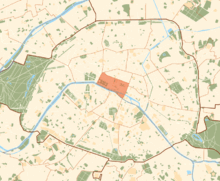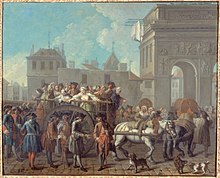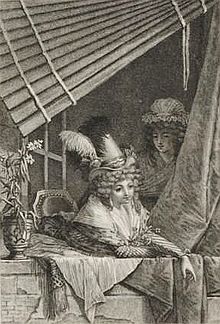
http://en.wikipedia.org/wiki/Prostitution_in_France
Prostitution in France (the exchange of sexual services for money) is not illegal, but several surrounding activities are. These include soliciting, procuring, operating a brothel (maison close, lupanar or bordel in French), living off the avails,[clarification needed] and paying for sex with someone under the age of 18.
During the Napoleonic era France became the model for the regulatory approach to prostitution. In the twentieth century a policy shift became apparent. Brothels became illegal in 1946 and France signed the Convention for the Suppression of the Traffic in Persons and of the Exploitation of the Prostitution of Others in 1960. With these moves France became a major supporter of the international abolitionist movement, advocating the eradication of prostitution. (See #Abolitionism in France)
The history of prostitution in France is similar to that in other European countries, with alternating periods of tolerance and repression (Tolérance générale, répression occasionnelle), but is marked by the length of time during which the maisons (brothels) were tolerated. Prostitutes were not marginalized, but integrated into society where they had a role to play. In stories (which were often ribald), prostitutes would be complicit with other women in avenging men. The great Cathedral of Chartres had a window endowed by prostitutes (The Prodigal Son) in the same way as other windows were endowed by various other trade guilds (The Trade Windows).[1][2][3][4]
[edit]Early period
After the period of Roman rule, the Visigoth monarch Alaric II (485–507 AD) seems to be the first French ruler to prosecute prostitution.
[edit]Middle Ages
During the Middle Ages the various authorities, civil or noble, oversaw prostitution as an institution. Regulation was largely at the municipal level, restricting activity on certain streets, travel, liaisons, required distinctive dress (gold belts, or ceinture dorée)[5] and opening hours of the maisons (10-6, or 10-8 in Paris).
Charlemagne (768–814 AD) was amongst those rulers who attempted to suppress prostitution, declaring flogging (300 lashes) as a punishment in his capitularies. This was primarily aimed at the common man, since harems and concubines were common amongst the ruling classes. Some idea of the seriousness with which the state regarded the offense is provided by the fact that 300 lashes was the severest sentence prescribed by the Code Alaric. Offenders also had their hair cut off, and in the case of recidivism, could be sold as slaves. There is no evidence that any of this was effective.[6][7] Under Philip II (1180–1223) an irregular militia, the Ribaud were created in 1189 to police prostitution and gambling, headed by a Roi des Ribauds, but abolished by Philip IV (1285–1314) due to their licentiousness.
[edit]Saint Louis IX (1226–70)
In the interim Louis IX (1226–1270) attempted to ban prostitution in December 1254, with disastrous social consequences and widespread protests. The decree ordered the expulsion of all 'women of evil life' from the kingdom and confiscation of their belongings, but simply drove the trade underground. Eventually he was forced to revoke this by 1256. Although still railing against women who were 'free with their bodies and other common harlots' he acknowledged the pragmatic desirability of housing them away from respectable streets and religious establishments, and so obliged them to reside outside of the borders of the city walls. His resolve to do away with prostitution was affirmed in a letter of 1269 to the regents, as he set out on theEighth Crusade, in which he refers to the need to extirpate the evil, root and branch. The punishment for infraction was an 8 sous fine and risking imprisonment in the Châtelet (see below). He designated nine streets in which prostitution would be allowed in Paris, three of them being in the sarcastically namedBeaubourg quartier (Beautiful Neighbourhood)[8] (Rue de la Huchette, Rue Froimon, Rue du Renard-Saint-Merri, Rue Taille pain, Rue Brisemiches, Rue Champ-Fleury, Rue Trace-putain, Rue Gratte-cul, and the Rue Tire-Putain) (see below)[9][10]
Today this area corresponds to the 1st–4th arrondissements clustered on the Rive Droite (right bank) of theSeine (see map). These streets, associated with prostitution, had very evocative if indelicate names including the Rue du Poil-au-con (or hair of the con, from the Latin cunnus meaning female genitalia, hence Street of the Pubic Hair, or Poil du pubis), later altered to the Rue du Pélican, in the 1st arrondissement, near the first Porte Saint-Honoré,[11] and the Rue Tire-Vit (Pull-Cock, i.e. penis, later the Rue Tire-Boudin, Pull-Sausage) now Rue Marie-Stuart, in the 2nd arrondissement, near the first Porte Saint-Denis. It is said that Tire-Boudin was a euphemism invented for Mary Queen of Scots when she asked after its name, and the street is now named after her.[12] The nearby Rue Gratte-Cul (Scratch-bottom) is now the Rue Dussoubs, and the Rue Pute-y-Musse (Whore can hide there) the Rue du Petit-Musc by corruption. The "rue Trousse-Nonnain" (fuck nun), later became Trace-Putain, Tasse-Nonnain, and Transnonain; then in 1851 it was amalgamated into the Rue Beaubourg.[13] The Rue Baille-Hoë (Give Joy) is now Rue Taillepain in the 4th arondissement near the Porte Saint-Merri.[14]
In 1358 the Grand Conseil of John II (1350–64) echoing the "necessary evil" doctrine of Saints Augustine(354–430 AD) and Thomas Aquinas (1225–74) declared that "les pécheresses sont absolument nécessaires à la Terre" (Sinners are an absolute necessity for the country).[6] Prostitution remained confined to designated areas, as indicated in this decree in the reign of Charles V (1364–80), by Hugh Aubriot, Provost of Paris in 1367, outlining the areas outside of which prostitutes would be punished 'according to the ordinance of Saint Louis';
Que toutes les femmes prostituées, tenant bordel en la ville de Paris, allassent demeurer et tenir leurs bordels en places et lieux publics à ce ordonnés et accoutumés, selon l’ordonnance de Saint Louis. C’est à savoir : à L’Abreuvoir de Mascon (à l’angle du pont Saint-Michel et de la rue de la Huchette), en La Boucherie (voisine de la rue de la Huchette), rue Froidmentel, près du clos Brunel (à l’est du Collège de France aboutissant au carrefour du Puits-Certain), en Glatigny (rue nommée Val d’Amour dans la Cité), en la Court-Robert de Pris (rue du Renard-Saint-Merri), en Baille-Hoë (près de l’église Saint-Merri et communiquant avec la rue Taille-Pain et à la rue Brise-Miche), en Tyron (rue entre la rue Saint-Antoine et du roi de Sicile), en la rue Chapon (aboutissant rue du Temple) et en Champ-Flory (rue Champ-Fleury, près du Louvre). Si les femmes publiques, d’écris ensuite cette ordonnance, se permettent d’habiter des rues ou quartiers autres que ceux ci-dessus désignés, elles seront emprisonnées au Châtelet puis bannies de Paris. Et les sergents, pour salaire, prendront sur leurs biens huit sous parisis…[15]
Contemporary accounts suggest that this decree was rarely enforced.[7]
The appearance of syphilis at the end of the 15th century had stigmatized these houses by the end of the 16th century, but their continued existence was confirmed by King Henry IV (1589–1610).[16]
Réglementation (Regulation)
In 1804 Napoleon ordered the registration and bi-weekly health inspection of all prostitutes. State controlled legal brothels (then known as "maisons de tolérance" or "maisons closes") started to appear in Paris and in other cities and became highly popular throughout the century. By 1810, Paris alone had 180 officially approved brothels.
By law, they had to be run by a woman (typically a former prostitute) and their external appearance had to be discreet. Prostitutes working in the maisons, or any woman arrested twice for soliciting had to be registered as such.[17] Registration involved having your name on a national register, and agreeing to abide by the regulations and twice weekly medical examinations.[18] This pattern of regulation rapidly spread throughout Europe, partly aided by the Napoleonic occupations.
Among the most expensive and best known maisons de tolérance in Paris were:
- le Chabanais (opened 1878 and favored by Prince Edward, who had himself made a special "love seat" there),[19]
- le Sphinx,
- le Montyon,
- la Rue des Moulins,
- le One Two Two (opened in the mid-1920s and soon became the top address)
- Hotel Marigny was the best known brothel for male homosexual clients; it opened in 1917 near Opera in the second arrondissement[20]
More sordid brothels, the maisons d’abattage, offering quick and dirty services, were popular amongst the lower-class.
The 19th century was also the time of several fabulously rich courtesans in Paris, with La Païva being the most famous one.
 Paris arrondissements, 1st highlighted, the 2nd and 3rd to the N. & 4th to the E
Paris arrondissements, 1st highlighted, the 2nd and 3rd to the N. & 4th to the E Étienne Jeaurat (1699–1789). "Filles de joie" being taken to the Salpêtrière 1745. Oil on canvas, Musée Carnavalet, Paris
Étienne Jeaurat (1699–1789). "Filles de joie" being taken to the Salpêtrière 1745. Oil on canvas, Musée Carnavalet, Paris
Prostitutes in Paris during the revolutionary period, c. 1793-95. Engraving by Jacques-Louis Copia (1764–1799), afterJean-Baptiste Mallet (1759–1835). Bibliothèque nationale de France
 Louis-Léopold Boilly (1761–1845). "Point de Convention" c. 1797 (Woman refusing money offered by a gentleman who has assumed she is a prostitute)
Louis-Léopold Boilly (1761–1845). "Point de Convention" c. 1797 (Woman refusing money offered by a gentleman who has assumed she is a prostitute)
This is a really awesome and helpful article for me. I really appreciate your work for providing such useful information, thank you so much! here my site: chiffon printed fabrics manufacturers
ReplyDelete